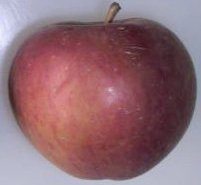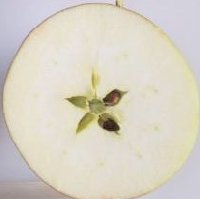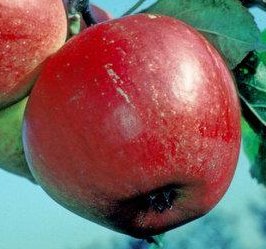PARENTAGE
The parents of Fiesta are Cox’s Orange Pippin and Idared. It was bred at East Malling Research and introduced in 1972. The RHS awarded Fiesta an AGM in 1993 which was reconfirmed in 2013.
APPEARANCE, TASTE AND CHARACTERISTICS OF FIESTA
Fiesta is in pollination group 3 making it an ideal pollination partner for the majority of other apple trees which are in groups 2, 3 and 4. It is partially self-fertile and although it benefits from a suitable pollination partner nearby, it will produce a good crop as a single apple tree.
Fiesta is suitable for growing in all areas of the UK and is a reliable cropper each year. Disease resistance is very good and it is rarely affected by the major diseases affecting some other varieties.
The apples are medium sized, regularly round with a red, orange and green colour. The flesh is creamy-white, very juicy, and crisp. Taste is very similar to Cox’s Orange Pippin, sweet but slightly acidic with a perfect apple aroma. It maintains these qualities when stored for up to four months.
Primarily used as a dessert (eating) it also cooks very well, retaining its shape. It produces lots of juice making it ideal for apple juices and cider production. You are unlikely to find apples of this variety for sale in supermarkets and shops. Apples are produced in September to early November (see below for more specific dates in your area), keeping in storage until March.
A Fiesta apple ready for picking
BUYING A FIESTA APPLE TREEE IN THE UK
Fiesta is one of the most popular dessert apple trees and a huge number of garden centres stock this variety. It is also very easy to order online in a wide variety of sizes and on all the popular rootstocks. If you order a bare-root tree in November / December then stocks will be high.
If you prefer us to suggest a supplier for this variety then Ashridge Nurseries are offering this variety at a good price and we can personally recommend them.
Remember that all apple trees need a stake to support them for the firstcouple of years and some require staking for life. So if you haven’t got a stake and a tie for your new tree then buy one when you order the tree for convenience. Fiesta is a an average variety as far as vigour is concerned so M27 and M9 rootstocks will need permanent staking. Grown on M26 rootstock it will require staking if conditions in your area are windy or the soil
conditions are poor
Because of the popularity of Fiesta apple trees they can sometimes be found at the lowest of prices in some of the supermarkets and DIY stores. Stick to bare-rooted ones and start looking from November onwards. Last year Aldi were selling them at silly, low prices and the trees were in good condition.
If you buy trees from these cheap sources you run the risk of two main problems. The first is that in a year or two disease problems may become apparent which were not visible at the time of purchase. This is very disappointing after such a long time. The second problem you may encounter is that the variety is not as specified on the pack.
ALTERNATIVES TO FIESTA APPLE TREE
When considering alternatives to this variety the key features to look for are a mid season apple tree, good looking green / red skin, long storage capabilities. It should also be partially or fully self-fertile and have excellent taste and aroma. The following have some or all of those characteristics:
- RED FALSTAFF – a widely available sport of Falstaff. Very similar to Fiesta in almost all respects, we would say that Fiesta tastes slightly better but it’s a very close call.
- SUNSET – slightly more acidic compared to Fiesta but only slightly. Tip top disease resistance. This is our choice for a container grown tree or for smaller gardens, the apple size is slightly smaller than average.
- COX’S ORANGE PIPPIN – only included in this comparison because it has an even better taste. It looks like a Fiesta, perhaps slightly smaller. The classic tasting British apple let down by poor disease resistance especially to scab. Moderate storage capabilities.
- LAXTON’S SUPERB – one of the top three best tasting apples of all time in our view. Slightly sweeter than Fiesta but still lots of apple flavour. This variety has no drawbacks, a great tasting apple with superb looks and good pest and disease resistance. Produces apples slightly later in the year.
SUMMARY CHARACTERISTICS OF FIESTA
USE: Eating also cooks well and holds much of its shape
SKIN COLOUR / TEXTURE: Mainly red, orange / green background
FLESH COLOUR: Creamy white
TASTE AND TEXTURE: Excellent balance of sweetness and background acidity, crisp and crunchy
FRUIT SIZE: Average
STORAGE: Four months
SUITABILITY FOR CORDON / ESPALIER GROWTH: Yes
TREE SIZE: Average size depending on rootstock and conditions
REGULARITY OF CROPPING: Very regular
READY FOR PICKING / HARVEST:
Last week of September
POLLINATION: Group 3, partially self-fertile but does even better with a suitable
pollination partner (see also the end of this list
here).
AWARDS: RHS AGM in 1993
reconfirmed in 2013
SPECIAL FEATURES: Superb looking and tasting apple, good disease resistance
FIESTA FLOWERING AND HARVEST TIMES:
The average flowering time (optimum time for pollination) and date when fruits are ripe in the UK for the Fiesta apple tree are set out below. If you have set your home town we can give you a more accurate estimate, if you have not set your home town (do it now by clicking here) the dates below will be the average for the UK.
Your town has not been set, the average main flowering time for Fiesta in the UK is the first week of May. Fruit will be ready for harvesting in the last week of September. Click here if you want to set the dates to your home town.
Flowering and fruit picking dates vary according to the weather in any particular growing season so the above dates may well change slightly from one year to the next. The flowering date above is when the apple tree produces the maximum number of blossoms, it will also produce blossom, although less, a week or two either side of the date given.
COMMON POLLINATION PARTNERS FOR FIESTA
Fiesta is self-fertile but in years with poor conditions it will benefit from a nearby pollination partner. This variety is in pollination group 3. Suitable pollination varieties include the following:
- Alkmene – pollination group 2, self-sterile, eater
- Arthur Turner – pollination group 3, self-sterile, cooker
- Beauty of Bath – pollination group 2, self-sterile, eater
- Bountiful – pollination group 3, self-sterile, cooker
- Braeburn – pollination group 4, self-fertile, eater
- Charles Ross – pollination group 3, partially self-fertile, cooker and eater
- Court of Wick – pollination group 3, self-sterile, eater and cooker
- Devonshire Quarrenden – pollination group 2, partially self-fertile, cooker
- Discovery – pollination group 3, self-sterile, eating and cider
- Dumelows Seedling – pollination group 4, self-sterile, cooker
- Egremont Russet – pollination group 2, partially self-fertile, eater and cooker
- Ellison’s Orange – pollination group 4, partially self-fertile, eater
- Falstaff – pollination group 3, partially self-fertile, eater
- Golden Delicious – pollination group 4, partially self-fertile, eater and cooker
- Granny Smith – pollination group 3, self-fertile, eater and cooker
- Greensleeves – pollination group 2, self-fertile, eater, cooker, juice
- Grenadier – pollination group 3, partially self-fertile, cooker
- Honeycrisp – pollination group 4, self-sterile, eater
- Howgate Wonder – pollination group 3, partially self-fertile, cooker and eater
- Idared – pollination group 2, self-sterile, eater
- James Grieve – pollination group 3, partially self-fertile, cooker and eater
- Kidds Orange Red – pollination group 3, self-sterile, eater
- King of The Pippins – pollination group 4, partially self-fertile, eater and cooker
- Laxtons Superb – pollination group 4, partially self-fertile, eater
- Lord Derby – pollination group 4, self-sterile, cooker
- Lord Lambourne – pollination group 2, self-fertile, eater and cooker
- Newton Wonder – pollination group 4, partially self-fertile, cooker
- Peasgoods Nonsuch – pollination group 3, partially self-fertile, cooker
- Rajka – pollination group 4, self-sterile, eater
- Red Windsor – pollination group 2, self-sterile, eater
- Red Falstaff – pollination group 3, partially self-fertile, eater
- Reverend W Wilks – pollination group 2, self-fertile, cooker
- Scrumptious – pollination group 3, self-fertile, eater
- Sops in Wine – pollination group 3, self-sterile, juicer
- Spartan – pollination group 3, self-fertile, eater
- Sunset – pollination group 3, self-fertile, eater
- Tydemans Late Orange – pollination group 4, self-sterile, eater
- Winston – pollination group 4, self-fertile, eater
- Worcester Pearmain – pollination group 3, partially self-fertile, eater
The full list of apple tree varieties which we have reviewed is listed below. Select any one of them and then click the “More Information” button to be taken to the in depth review:



Rootstocks and Size
Guide to Planting
Care Plan
Pruning Apple Trees
Harvest and Storage
Pests and Disease
Pollination Groups
FIESTA APPLE TREE
Fiesta was bred by the East Malling Research Centre and first introduced for sale in 1972. The parents are Cox’s Orange Pippin and Idared, both excellent varieties in their own right.
Generally a very healthy variety, Fiesta is suitable for growing in all areas of the UK. It is used primarily as a dessert variety suitable for eating immediately when picked but stores extremely well for around four months. This variety can also be used as a cooking apple, holding its shape well. If it has any fault it is probably that it can occasionally be affected by scab although this only occurs in adverse conditions.